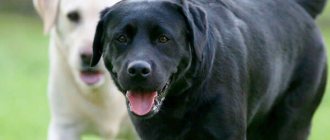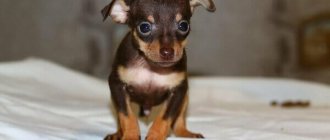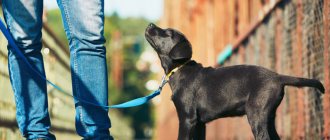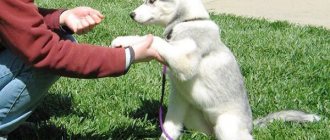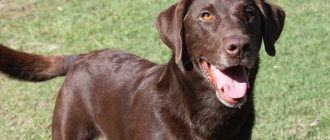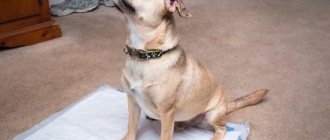Before you bring a Labrador into your apartment, weigh all the pros and cons and study the reviews of the owners. This is a kind, smart and very active breed of dog. The best place for her to live would be a private house. In urban conditions, considerable participation of the owner will be required to ensure a full life for the dog.
Consider whether you can give your pet enough attention. After all, this is not a decorative toy, but a dog with a serious hunting past. Training and energetic play will take up a lot of time in your regular schedule.
Is it suitable for living in an apartment?
Active dogs, which include the Labrador, need adequate physical activity . First of all, the state of health, both psychological and physical, depends on this.
Any breed of dog can be kept at home if it is given proper attention. Frequent long walks, active outdoor games and training.
If the Labrador is not stressed, then in the first years of its life it will dump excess energy into destroying its home . How could it be otherwise if he is locked within four walls?
Over time, the dog imitates the lifestyle of its owners. Lazy people are not recommended to own Labradors. Without activity, dogs quickly gain weight due to metabolic disorders .
They become as lethargic as their owners, which is contrary to the nature of this breed.
Advantages and disadvantages
Before you start keeping a Labrador in an apartment, you should note several disadvantages of this decision.:
- the need to provide daily active load;
- the dog is recognized as a source of infections;
- the presence of long hair - during seasonal molting, the hair needs to be combed every day, intensive cleaning of the room and cleaning of furniture will be required;
- the need to devote a lot of time to the education process.
But all these disadvantages are fully compensated by certain advantages.:
- the appearance of a faithful friend;
- the labrador will happily go for a run with its owner in the morning;
- gets along well with children and can become a nanny;
- will not offend family members;
- With proper training, it performs security functions, although it is considered a completely non-aggressive dog.
Advantages and disadvantages
It should be noted that keeping such a large dog in an apartment has certain disadvantages :
- organizing walks and training, which takes a lot of time;
- the dog is the source of infection;
- hygienic reasons, since the dog has long hair;
- You will have to devote a lot of time to education.
If the owner loves pets and is ready for all difficulties, this will not be a big obstacle.
Besides, having such a friend has many advantages.:
- walking a dog, a person himself has a good opportunity to breathe fresh air;
- positive emotions;
- having a loyal friend who is always ready to help;
- the kindness and responsiveness of the animal;
- friendliness;
- activity;
- devotion;
- ideal companion;
- Labrador does not bark without a reason.
Is it suitable for outdoor use?
Dog experts have different opinions about keeping a Labrador outdoors. This breed was bred as a hunting companion. Keeping it on the street should not mean that the dog is left to its own devices and is on an independent walk.
Loneliness has a negative impact on the animal’s psyche, so to keep a dog on the street, you must not deprive the dog of communication with family members.
Only joint walks and games compensate for the lack of attention.
Labradors can tolerate low temperatures. But for central Russia, for a dog to live on the street, it is necessary to take care of insulating the enclosure in winter.
The animal should have enough space to stretch out its paws and walk around . Always ensure there is clean water in the bowl.
An insulated enclosure, with lighting, and a large area is an acceptable option for keeping a Labrador outdoors.
Advantages and disadvantages
An aviary is the only option for keeping a Labrador outdoors.
The booth is not suitable for several reasons:
- A dog on a chain psychologically feels responsible for what is happening; it’s the same as a leash. She cannot relax and is always tense. The enclosure is like a cage, with a secluded place for the dog to rest and a small area for eating, with minimal space for activity.
- In an enclosure, the dog is better protected from precipitation: snow, rain. The wooden podium protects from dirt.
Among the advantages is that the dog is always in the fresh air . Seasonal temperature changes affect the formation of the coat gradually, which is completely different from apartment housing, centralized heating in the winter months.
This does not mean that a dog living on the street does not need to be brushed. This needs to be done less often.
A Labrador living outdoors needs more careful inspection . Enhanced protection against ticks and fleas. It is necessary to ensure that there are no other sick animals in the area.
Description of the Labrador's character
The main characteristics of this dog are good nature, playfulness, balance and cheerfulness. They can infect everyone with their optimism. The peculiarity of the pet's character is its loving nature and friendliness towards everyone. Combined with his lack of aggression, this makes him completely unsuitable for the role of a security guard.
Labradors in nature
Another character trait is intolerance to loneliness. The pet's need is to be close to the owner, serve him and obey him. In terms of devotion and fidelity, the Labrador has no equal. But for this reason, he cannot be kept in an enclosure or on a chain, or left alone for a long time.
Genetically, the nature of the Labrador breed includes the need to bring prey to the owner. Without proper upbringing, he can hunt birds, pick up and bring various objects on the street. These dogs love water, so lying in a puddle is considered a fun activity.
Features of training Labradors
Training this dog will not be difficult even for an inexperienced dog breeder. These dogs are so intelligent and obedient that they learn simple commands quickly. They remember and understand several hundred phrases that are often spoken in their presence.
Chocolate color
In addition to the basic course, Labradors can be trained in more complex ways. It is easy to teach them to fetch a stick, a ball, or catch a disc. These pets are suitable for canine sports and love to run with their owner. They are happy to learn; it is best to use praise, affection or treats in training. You should not use punishment or even beat your pet; he understands the strict tone.
Without proper upbringing, a Labrador can become touchy and disobedient. Without communication with a person, he gets bored, gets sick and becomes depressed.
Basic rules of care
Training is the basis of mutual understanding between owner and dog . It also gives the pet an intellectual challenge. To live together with a dog in an apartment, it is important to develop self-control and develop stable behavior.
Loud barking, loud whining and running around will cause a lot of trouble for the neighbors.
You need to teach the puppy to calm down and strictly follow commands. Then there will be no problems with an adult Labrador in the apartment, even if he meets a cat at the entrance.
Active games and sports training are the key to ensuring that the dog gets the necessary physical activity . This is very important for apartment pets.
Being alone, they experience stress and try everything. So, the dog struggles with emotions. A tired dog goes to bed after a walk.
Curious puppies often chew on shoes and other accessible objects due to teething . You can ensure their safety by putting things away in advance.
All wires and cords must be kept out of reach. Small, fragile objects at an unattainable height.
Expert opinion
Kozhevin Semyon Kirillovich
Expert dog handler.
Labradors can be kept in an apartment provided that early training begins. First of all, the pet is taught to go to the toilet, to a specially designated place and not to bark loudly. If during training the animal does not succeed in everything right away, then under no circumstances should you raise your voice at him, as this can harm his psychological state. Daily walks are required; if the pet is taken for a walk, it will not cause any problems in the apartment.
Buying an adult dog
If you have decided to adopt an adult Labrador, then do the following:
- Find out if he has experience with children. An adult dog could get used to a quiet, lonely life. Once in a new family, she may not be delighted with the child’s desire to play or cuddle;
- See how the dog behaves at home and outside. It is important that she is obedient and follows at least basic commands;
- Be prepared for the need to wean your animal from bad habits. For example, it can chew furniture or other things. It will take time and patience to wean yourself from such habits, since adult dogs are less adaptable to new rules than puppies.
Labrador is a very good-natured and playful dog. These qualities make her an ideal pet for a child of any age. The Labrador will gladly take part in outdoor games, will readily fetch various objects and obey its little owner.
First days at home - what should you do?
Before the puppy appears in a private home, you need to purchase a number of necessary things:
- toys;
- feed;
- bowls for food and water;
- dog bed or mat;
- brush.
Puppies don't know how to endure . Therefore, it will not be possible to avoid puddles, but the animal can be trained to go in a diaper or in a litter tray - you need to take care of the place in advance.
General characteristics of Labrador
Labrador Retrievers are so called because they belong to the retriever group. They are classified as medium-large breeds, compact in size, but with a powerful build. The height at the withers of an adult male can reach 60 cm, but the weight of Labradors is no more than 35 kg. With proper care they live 12-14 years.
Labrador puppy
This breed is popular all over the world. Not only ordinary dog breeders, but also professional dog handlers consider her the most obedient, devoted, hardworking and smartest. Anyone can have such a pet, since the price of even purebred puppies is low.
The advantages of these dogs
This is one of the few large dogs that are suitable for living in an apartment. They are unpretentious and easily adapt to any conditions. But the Labrador breed also has many other positive qualities:
- they are friendly, not at all aggressive, loyal;
- sociable, but balanced and calm;
- love children, can become an ideal nanny for a baby;
- easy to teach, as they are smart and quick-witted, they understand not only words, but also intonation;
- very playful and active, always ready to play, support the owner in everything;
- flexible, live quietly in the same house with other pets;
- efficient, hardy;
- unpretentious, do not require special care, except for the molting period;
- They are distinguished by a beautiful exterior and artistry, so they always attract attention.
Disadvantages of the breed
But before you get a Labrador Retriever, you need to know about its disadvantages. There are few of them, they are easily corrected by proper upbringing. Many dog breeders call this breed ideal, but Labradors have the following disadvantages:
- clumsy, like to chew on everything, so things in the house may get damaged;
- very active, you need to walk a lot with them;
- loving, good-natured and trusting, joyfully greeting all people, can jump on strangers;
- They have an insatiable appetite, they pick up everything in sight on the street, they love to beg, therefore they are prone to obesity;
- Labradors are not suitable for a small apartment due to their rather large size;
- cunning and intelligent, if trained incorrectly, can manipulate the owner;
- They shed twice a year and very heavily.
Who are they suitable for?
The Labrador Retriever is suitable for keeping in any home. It can be kept both in an apartment and in a private house in the yard. In the latter case, he needs a warm, spacious enclosure. But this pet does not tolerate loneliness, and also does not have protective qualities, so most often Labradors are kept in the house.
Fawn Labrador
This breed is suitable for any people, even those inexperienced in keeping animals. A family with a child should have them, as they love children very much and will never offend them, no matter what they do. These pets easily adapt to the habits and lifestyle of the owner and find a common language with all family members.
But due to its activity and energy, this breed is not suitable for homebodies or people leading a sedentary lifestyle, because they need to be walked a lot. They are worth getting for athletes, hunters, and travelers. The pet will accompany its owner everywhere; this breed is ideal for agility, bike joring, freestyle, and enjoys catching Frisbees and running after a stick.
Labradors are ideal guide dogs. They are easy to train, intelligent and friendly. They become the best companions for the disabled, guides for the visually impaired, and friends for children with socialization problems. This breed is most suitable for canistherapy - a method of treatment and rehabilitation with the help of animals.
Labrador on a walk
Labradors are often used in police service because these dogs have a very sensitive sense of smell. They easily find drugs, explosives, and missing people. But they cannot guard the territory or detain a criminal, since they have absolutely no aggression.
A description of the characteristics of a guide dog, how they are raised and how important they are for blind people can be seen in the video.
Interesting Facts
Labrador dogs are very popular, but most dog owners know them only as loyal companions. Although these animals have an interesting history, and a lot of unusual things can be told about them.
- The breed is called a Labrador Retriever, so they are often identified with Golden Retrievers. But these are two different breeds, differing both in appearance and behavior. Unlike the Labrador, Golden Retrievers have one color option, longer coats, and a graceful build.
- The Labrador is the best swimmer among dogs. Thanks to its webbed feet and specially shaped tail, it easily floats on the water, moves quickly and dives well. And the special waterproof double wool allows you to swim even in cold weather.
- Labrador is classified as a service breed, but not because of its protective qualities. They do not have a sense of their own territory or aggressiveness towards strangers, but they have great efficiency, devotion and obedience.
- Labradors are dogs that are almost insensitive to pain. Thanks to these qualities, they are ideal for rescue work, searching for missing people, and police work. They have a very sensitive sense of smell, which allows them to be used to search for drugs.
- The great thing about the Labrador Retriever is that he can easily control his jaw muscles. This dog will never bite a person, even by accident. They can carry a raw egg in their mouths without damaging it. Therefore, for families with children, the Labrador is an ideal pet. But he loves to chew on everything; he can eat furniture, linoleum, and shoes.
- These pets become mature late, they act like puppies until they are 4 years old. But even as an adult, the Labrador will be playful and mischievous. These are very positive dogs, cheerful and good-natured.
- Previously, Labradors were called St. John's dogs or small Newfoundlands. This is due to the history of the origin of the breed.
Where is the dog's private place?
Dogs have distracted attention. This does not mean that they cannot concentrate and are easily distracted.
This indicates that the dog is always busy with something..
Either he sniffs something, or he watches the behavior of the owner. The next minute he’s already chasing his tail. At the same time, he can quickly take off from his place for his favorite toy if he calls out to it.
The owner and his family are the most important people for a pet. The animal will not leave them without attention, no matter what they do. Happy to join you for lunch and take part in the game.
Labradors are people-oriented by nature . They will keep company while watching TV, sitting closer to their person. They will obediently wait for the time to walk.
Given these points, the dog should have its own place in the house so that it can relax and not be distracted . A secluded corner is chosen for the pet, even before the puppy arrives in the home.
Positive associations are formed through encouragement.
CAREFULLY!
You should never scold a dog when it is in its place. Children and other family members should not be allowed to handle the puppy.
“Place” will become an effective command so that the dog does not interfere when other people come to visit and does not get in the way.
Adaptation of a pet to an apartment
When a little Labrador appears in an apartment, he will need maximum attention and careful care. There should always be someone from the family nearby. You need to play with the baby and treat him with treats. Pick up only when necessary, carefully but firmly grabbing under the chest and seat. You can’t pull, let alone lift, by the paws - they can easily be damaged. If the floor is slippery, choose an inexpensive pile flooring.
A puppy cannot be kept in the dark for a long time - this will upset the psyche and cause a number of diseases, including rickets.
When feeding in the first days, place a bowl with a small amount of food in front of the puppy and, as he eats, report it: he should see that food appears from your hands, this will increase trust.
To raise a mentally balanced dog, do not scold and especially do not punish the baby in the first days, even when he does shit. Now it is more important to establish contact! Just hide anything he might chew on (wires, shoes, hanging curtains, etc.) and remove carpets.
Similar article: Standard and non-standard Labrador color varieties
We choose a place away from heating devices and drafts, not on the aisle. Labradors love heights, but for the puppy it should be small so that he does not fall. If possible, buy bedding in advance and before picking up the puppy, ask the breeder to keep it in the dog room for several days: feeling the smell of the family, the baby will be less bored.
We recommend this article:
Weight of a puppy and an adult Labrador by month
How to feed?
It is difficult to answer unequivocally what diet to choose for a dog without consulting a veterinarian and assessing the state of health.
The markets offer a huge range of dry food and wet canned food for large breeds of dogs. You can feed your Labrador with natural food by first creating a balanced menu .
Dry food is easy to use. It is enough to calculate the required daily intake based on the age and weight of the animal. You should always make sure your dog has clean water in his cup. Sometimes the diet can be varied with wet food.
Natural nutrition is difficult in that it is necessary to include in the diet daily:
- meat;
- cereals;
- vegetables.
If your pet develops an allergy, it will take a long time to find out which product. Excluding one by one, then the other. It is necessary to regularly give your dog vitamins.
You need to be careful with dairy products, they can cause diarrhea.
For the first few weeks, puppies should be fed the same food they received from the breeder. If this is not dry food, then you should provide a similar menu as much as possible.
Mixing homemade food and dry food is harmful . They have different contents of useful elements and proteins, which disrupts metabolism.
Feeding your dog chips, sweets and any food from the table is prohibited. Sugar is bad for all dogs. Fried foods cause cardiovascular disorders. Fatty – disrupts the functioning of the gastrointestinal tract.
Labradors do not need a varied menu . The main thing is that they receive a sufficient amount of vitamins, proteins and carbohydrates from food. Sometimes you can treat your dog to a beef bone or carrot.
Dogs are not allowed:
- onion;
- mushrooms;
- nuts;
- chicken and fish bones;
- citrus;
- berries.
Master's Code
A loyal friend, companion, assistant - that's all he is, a Labrador; caring for and keeping a representative of the breed at home can seem quite complicated. This is an active dog that needs to run around and splash out its energy. In addition, due to its considerable size, it consumes quite a lot of feed.
Labrador is an excellent companion and faithful friend for many years
For your information! Those owners who decide to stick to natural food will have to cook especially for the dog, and in large portions.
Before you make the final decision to become a Labrador Retriever owner, you should familiarize yourself with the following owner code:
- There are no bad dogs. There are unscrupulous and irresponsible owners;
- The standard life expectancy of dogs is 12-18 years. All this time he will need to be taken care of, walked every day, regardless of the weather and health;
- an animal is not a toy that you can get rid of after deciding that you are tired of it. This is a living creature with its own character and habits;
- it's important to be consistent. The cute antics of a puppy who loves to affectionately bite his owner’s legs will no longer be so touching as he grows up. Therefore, from early childhood, all prohibitions are practiced clearly. If you can’t, then you can’t forever;
- training and training should be carried out according to the principle from simple to complex. A “carrot and stick” policy without physical violence and aggression is the choice of a responsible owner. “Whip” in this case is a stern tone, a demonstration of displeasure;
- The dog's nutrition is the responsibility of the owner. A dog is not a pig, waste from the human table is not suitable. They either prepare it separately or buy ready-made industrial feed;
- The veterinarian is a specialist whom you will have to get to know. Preventive examinations should become a good habit. It is better to prevent any disease than to treat it.
These are the main points that a Labrador owner should consider.
The Labrador will become a true friend to its owner, but needs proper training
How often should you go for walks? How long should you walk?
Retrievers were bred as hunting dogs, capable of following a person on a hunt for a long time. Run after shot game over a long distance, overcoming any obstacles in your path. These large dogs are distinguished by their endurance.
Therefore, it is advisable to walk your dog two or three times a day.
In the morning, this can be a jog with your pet or an active game, which will give the animal energetic relief.
Duration of at least half an hour . Better is more. A tired dog will not smoke while the owner is not at home.
Evening exercise should be combined loads. The dog must be given commands while walking. Exercises for endurance. Running behind a bicycle or practicing sports equipment (agility, Frisbee) makes the walk exciting.
Labradors love to swim . Swimming does not put a lot of stress on the joints, but it is active physical work for the dog.
Adult dog diet
Nutrition and care for your Labrador are very important. An adult dog is fed either natural food or ready-made dry food. Two meals a day are expected at certain times, since discipline is very important for representatives of the breed.
Animals are very energetic, so they should be provided with a sufficient amount of protein food to be active. The diet includes offal, as well as greens and boiled vegetables.
It is very important to feed your dog properly
Do you need clothes? Harness or collar, muzzle - which is better?
The Labrador has a dense coat and undercoat. Thick wool protects against sudden changes in temperature and allows you to comfortably endure minor frosts.
They do not need clothes for walking . A raincoat or a thick raincoat for a walk in the forest in the off-season will provide additional protection for the dog from ticks and thorns. Will keep your wool from getting wet when it rains.
A small puppy is taught to walk on a leash with a harness . You can start with a leash. The advantage of the harness is that it reduces the strain on the neck thanks to the straps on the chest. The pressure is on the powerful body. The harness is a great option for jogging.
In the city you need to learn to walk on a leash with a dog . Through it, the dog feels every movement and twitch more intensely.
Appearance
Head and neck:
- The wide skull and lack of fleshy cheeks make the head powerful;
- The transition from forehead to muzzle is well defined;
- Correct bite, teeth are of medium size;
- Hazel eyes;
- The ears are mobile, set behind the head, usually take a hanging position, easily change it due to the absence of strong gravity;
- The neck is strong and strong.
Body and tail:
- Smooth back line;
- Wide chest with compressed ribs;
- The tail should not curl over the back; resembles an otter's tail; has a thick coat of fur.
Limbs:
- Straight line of the forelimbs, development of the hind limbs;
- The feet are round and compact, with webbed toes and pronounced pads.
Wool:
- Thick short six;
- The undercoat is waterproof.
How to toilet train a puppy?
Puppies go to the toilet immediately after sleeping and eating. You can teach them to relieve themselves in a specific place using a diaper or tray. It is necessary to monitor the puppy and put him on a diaper prematurely. When he does his business, they reward him with a treat.
You need to gradually teach your dog to relieve himself outside . Up to six months, the puppy can always ask himself. Therefore, you should not remove the diaper, but you should try to make the dog learn that this should be done outside.
To do this, you should go out with him more often, after eating..
Possible diseases
Over time, the puppy may develop osteochondrosis, dysplasia or paraproctitis. Eye diseases and food allergies are possible.
Do not try to treat your Labrador at home; if there are any symptoms of illness, immediately show it to a specialist.
Before all vaccinations have been completed, the puppy should not be taken outside. Outdoor shoes need to be hidden at this time - he can catch an infection simply by licking them.
How to trim claws and when?
A Labrador's nails get worn down when the dog walks outside. As they age, all dogs need to have their hair trimmed a couple of millimeters. You can start at one month of age if the puppy is inactive.
IMPORTANT!
The first procedure for trimming claws is best done by a specialist so that he can show the owner how to do it correctly.
Use a nail clipper; for a small puppy, nail clippers are suitable . The main danger of the procedure is that when cutting the claws, you can hit a blood vessel and bleeding will begin.
A bleeding cut should be immediately treated with a solution of potassium permanganate or hydrogen peroxide.
A Labrador must be taught all hygiene procedures from puppyhood . While the dog is small it is easier to conduct them. Be sure to reward the dog for exemplary behavior.
Photo gallery
If you have taken responsibility for your four-legged friend, you need to see the matter through to the end, and do not despair when any problems arise along the way.
How to clean your ears?
A healthy animal has clean ears; there is no need for frequent procedures. The only thing you need is to regularly examine your Labrador's ear to assess its condition.
An unpleasant odor and discharge are a sign of infection . Frequent ear cleaning disrupts the natural microflora, reducing protective mechanisms.
To carry out the procedure, soak a cotton pad in warm water and roll it inside the ear. If there are barely noticeable traces of earwax, yellow in color, there is no need for cleaning. Excessive brown earwax discharge requires its removal.
Before the procedure, the dog must be calmed . To stroke the area of the ears at their base. This massage will relieve tension and soften wax in the ear canals.
Cleansing products may vary:
- powder;
- medicinal lotion;
- drops.
Under no circumstances should you clean your Labrador's ears with hydrogen peroxide . It can cause a burn to the eardrum.
Labrador's ears are floppy. The outer and inner areas should be carefully wiped, without sudden movements, without twisting the ear. A bandage soaked in cleanser or warm water is suitable for this.
Special cotton swabs for dogs will help gently clean the ear canals.
Health and life expectancy
With proper care, Labradors live 10-14 years.
Health problems and prevention:
- Many diseases in Labradors are hereditary. You should ask breeders about the health status of the puppy's parents.
- Dysplasia is a defect in the hip joint. To avoid this defect, you need to closely monitor the puppy. Until the age of 6 months, he should not be exposed to physical exertion and should not move up the stairs independently.
- Diabetes and obesity. Everything here is actually simple - proper nutrition and balanced exercise. To check whether you have overfed your Labrador or not, feel the ribs. They should not be visible, but should be felt.
- Allergy. The main cause of attacks is food, chicken being the most allergic. For prevention purposes, you can use a 1-3 week course of enterosgel. You need to make sure that the Labrador eats, and do not allow your friends to treat him with anything. Self-medication is not suitable in this situation. You need to go to the vet immediately.
It is necessary to be vaccinated against canine distemper, infectious hepatitis, rabies, parvovirus enteritis, parainfluenza, leptospirosis.
Grooming. How long does shedding last?
The Labrador's coat has a dense structure and a thick undercoat, thanks to which it tolerates low temperatures and can swim in cool water.
In girls, shedding is more intense before estrus, due to hormonal changes . Males shed during the changing seasons.
Labradors cannot be cut or shaved. This disrupts natural heat exchange. In hot weather, the dog will overheat, and in winter it will freeze.
Labradors need to be brushed frequently . The coat is constantly renewed; if the coat is not taken care of, the dog will develop skin problems.
For combing, use a comb with fine metal teeth. The Furminator is a comb with a small blade that will delicately thin out the fur and remove fluff from the undercoat.
During shedding, the dog needs to be brushed daily . Typically, shedding lasts from one to two weeks. This is a painless period for the dog. A new cover is formed immediately.
Bathing during shedding will help get rid of old fur faster.
NOTE!
If the new coat looks dull, and the old one is coming out in clumps, you need to increase the amount of nutrients and proteins in the Labrador’s diet.
No need to change your diet. Vitamins in drops or tablets will help your pet’s body cope. Prolonged shedding with similar symptoms is a reason to contact a veterinarian.
Puppy diet
Caring for a Labrador requires proper organization of feeding from childhood. Puppies are given ready-made industrial food aimed at this age group (Akana, Brit Care brands). From natural food it is permissible to offer the following products:
- lean meat;
- boiled sea fish (boneless fillet);
- dairy products;
- cereals (rolled oats, buckwheat, rice);
- eggs (1 per week).
Note! Each product is introduced into the diet carefully; the baby’s well-being must be monitored.
How to bathe and how often should it be done?
The homeland of Labradors is the island of Newfoundland. As island dogs, they love to bathe.
A healthy animal does not have a distinctive odor; if the dog’s fur smells bad of a dog, this may indicate fungal diseases or that the dog has not been washed in clean water for a long time.
Frequently washing your pet in the bath is not recommended. Hard running water disrupts the functioning of the sebaceous glands.
You should bathe your Labrador no more than once every two to three months . Use only special shampoo for dogs that does not dry out the skin. If the dog still needs to be washed unscheduled, then the shampoo is replaced with coat conditioner.
Do not blow dry your Labrador . The wool should dry naturally.
After bathing, the dog can be dried with a soft towel or cotton diaper.
History of Labradors
This breed has a short history; it appeared only in the 19th century. Breeding was carried out in the UK, although the birthplace of Labrador retrievers is Canada. These efficient dogs were also called small Newfoundlands, as they were common on this island. There they helped fishermen and hunters. The history of origin is still unclear: either the British brought a ready-made breed to Europe, or they took out its ancestors and started breeding them in Great Britain.
Labrador
The origin of the name is also unclear. According to one version, the Spaniards named the dogs this way, since labrador translates as “hardworking.” According to another version, these dogs originate from the island of Labrador. There is also an option that they were named so because of their black shiny wool, reminiscent of the labradorite stone.
At the end of the 19th century, the British presented the first black Labradors at an exhibition. 1870 is the time of the birth of the breed. A few years later, the first standard was approved, according to which only black dogs were recognized. Two more varieties of Labrador color became standard only at the end of the 20th century. Labradors in fawn, chocolate, and white colors are now popular.
Labrador mouth
In Russia, the breed began to be bred only in the 70s. After one Labrador was brought to Moscow, interest in them arose. But due to the lack of fresh blood, they were first crossed with Newfoundlands. Only since the mid-90s did they begin to meet international standards. Nowadays there are many kennels operating in Russia, the dogs from which take prizes at international exhibitions and live with dog breeders all over the world.
How to brush your teeth?
For dogs, you can add a special liquid to the water that prevents the formation of plaque and freshens breath. It will not replace brushing your teeth, but it will support your oral health.
You need to brush your teeth with toothpaste for dogs . Brushes can vary in size and have a massage effect.
Before cleaning, wash your hands thoroughly, and let the dog try the paste. A gum massage is performed. Over time, the dog will get used to manipulations with its muzzle and will allow it to brush its teeth more thoroughly.
Teeth should be brushed no more than once a week and no less than once a month . An alternative to regular teeth cleaning is a bone.
Nutrition
At first, a Labrador puppy really needs to get food more often than an adult dog. But leaving a bowl of food in your absence is absolutely forbidden. This will teach the puppy the rule that you can eat whenever you want and as much as you want. This means you can forget about a balanced diet. In addition, out of boredom, a Labrador may start playing with food.
Expert opinion
Anna Abramenko
An avid dog lover. Experience in veterinary medicine since 2009.
Ask a Question
The dog needs to be scolded according to the “here and now” principle. If the “crime” occurred in the absence of the owner, the baby may no longer remember what exactly he did, which means he will not understand at all why he is being punished.
Cage for a Labrador in an apartment
A dog crate can become a full-fledged secluded place, or vice versa – a cause of stress. Labradors dote on people.
For full psychophysiological development, a dog needs to move and communicate with a person . In many situations, a crate is considered the only solution for a dog's safety.
For example, when there are small children at home who may unknowingly torment the puppy, other animals, repairs.
A dog cage should be larger in size than a regular carrier . Choose a large one with a solid base so that the dog does not accidentally knock it over or move it from its place.
The acceptable height of a cage for a Labrador retriever exceeds 60 cm. The dog should feel free in the cage, be able to stretch its paws, and stand without bending its head.
Choose a cage for growth and from a durable material that is easy to care for.
Choosing a Labrador puppy for a child
When buying a puppy for a child, you need to consider the following points :
- For calm children, it is better to choose females. They have a more flexible character. For active children who want to play and run with their pet more often, male dogs are more suitable. Males are active and strong, so they are almost always ready for active entertainment. They are also less likely to be stubborn and more willing to obey commands;
- The nursery should take puppies that are approximately 7 months old. At this age, many character traits are already noticeable;
- In terms of the puppy's character, focus on the golden mean. You should not buy a puppy that is too timid, but also do not buy one that shows aggression;
- The puppy should be moderately well-fed.
Features of outdoor maintenance
To form a stable psyche in a dog, it needs socialization. A Labrador can live in an enclosure or on the street, but you should not expect that it will become a watchdog.
For this breed, aggression is a pathology, an undesirable behavior . If for some reason it is not possible to keep a dog in the house, then when setting up an enclosure, you need to be prepared to pay no less attention to it.
A dog shouldn't feel lonely.
It is allowed to let the dog run around the territory, under supervision, as often as possible . Keeping them outside does not replace the need for long walks, active games, and intense physical activity.
It is worth taking care of seasonal temperature changes and insulation.
Choose the right place for the enclosure: secluded, partial shade, not in a draft . It is better that this is the inner part of the yard, not facing the entrance. Otherwise, the dog will worry every time and whine when people come or leave the house.
A big dog means a big responsibility. A small plush puppy is irresistible, but you need to realize that a small Labrador will grow up quickly, psychologically remaining a puppy until the age of three.
Breed traits
Breed traits (on a 5-point scale)
| Labrador Retriever | |||
| Activity | in the house | 3.4 | |
| on the street | 4.4 | ||
| Obedience | training | 4.2 | |
| strangers | 4.2 | ||
| Domination | in family | 1.8 | |
| over dogs | 2.4 | ||
| Defending your territory | from people | 2.2 | |
| from dogs | 2.5 | ||
| Sociability | in family | 4.9 | |
| with strangers | 4.1 | ||
| with dogs | 3.7 | ||
| Concentration | in family | 1.1 | |
| in front of strangers | 1.6 | ||
| with dogs | 1.6 | ||
| Aggressiveness | in family | 1.2 | |
| to strangers | 1.8 | ||
| to the dogs | 2.2 | ||
| to cats | 2.2 | ||
| Family behavior | calmness | 4.6 | |
| demand for affection | 4.6 | ||
| excitability | 3.6 | ||
| playfulness | 4.5 | ||
| excessive barking | 2.6 | ||
| behavioral breakdowns | 2.7 | ||
| Tolerance for children | up to 4 years | 4.4 | |
| over 4 years old | 4.6 | ||
| Institutional use | watchman | 3.7 | |
| bodyguard | 1.9 | ||
This breed is often compared to the following dog breeds: German Shepherd, Rottweiler, Beagle, Doberman Pinscher, Cane Corso.
Results
But at the end of all reviews about Labradors, the owners note that despite all the shortcomings of the breed, it is their fault, since some point was missed in raising the puppy. In cases where the dog was not the first in the family and the owners took their upbringing and training with greater responsibility, it is noted that this is not just a dog, but a real family member who will not be exchanged for anyone else.
Owners of Labradors in the apartment speak of the breed as requiring a lot of toys and personal items. By constantly buying your dog something interesting and chewable, you save your belongings and interior, and the dog plays enthusiastically while he waits for you from work.
In any case, you should remember that all the strength that you put into a Labrador puppy will return to you threefold in the form of a kind, cheerful and cheerful dog that will leave an indelible mark on your heart after its last breath.
Content Benefits
Most people who dream of owning a Labrador believe that this is the best breed. Attractive appearance, devotion to the owner, high intelligence, cheerful character. In this case, this list of advantages can be supplemented:
- If you need the perfect companion , then the Labrador is best suited for this. Even as a puppy, the dog quickly becomes attached to its owner and pleases its owner with its devotion throughout its life.
- Labrador is an active dog that requires constant walks, regardless of weather conditions. If you lead a healthy lifestyle and maintain physical fitness, then your pet will be happy to share these aspirations, being a reliable running partner.
- Like all breeds with a straight, medium-length coat, this dog does not require grooming , which makes caring for its thick coat much easier. To maintain shine and beauty, you need to comb your pet once every 3 weeks using a furminator. The device perfectly removes dead fur from the surface, thereby improving the appearance of the coat. After walks in nature, the fur should be combed with a metal comb, this will help get rid of thorns.
- The animal is unpretentious in nutrition, as it has a good appetite . You can give your pet homemade food or dry food.
- Puppies quickly learn commands , but training must begin almost from a few weeks of the pet’s life.
Interesting Facts
- French dog handlers use Labradors to search for truffles that grow deep underground. Competitions are held periodically, the winner of which is the dog that finds the largest number of mushrooms.
- Labrador Retrievers have webbed toes. This anatomical feature increases the dog's mobility in the water.
- Labradors have a high pain threshold.
- The dog loves to chew and carry various objects in its mouth.
- The dog can accelerate to 20 km/h in 3–4 seconds.
- The Labrador's sense of smell is better developed than that of the German Shepherd.
- An animal that acts as a guide can remember up to 50 different routes.
What is the difference between a Golden Retriever and a Labrador Retriever?
Many people confuse Golden Retrievers and Labradors. These two breeds do have many similarities. These are smart, cheerful and good-natured animals. Golden Retrievers and Labradors were bred for hunting. They swim well and can get game from thorny bushes or marshy swamps.
Golden has a calmer and more balanced character. If your family has small children, then it is better to get a Golden Retriever. Labradors sometimes get so excited about playing and running that they knock over small children. The Golden Retriever has a long, wavy coat that should be brushed daily.


